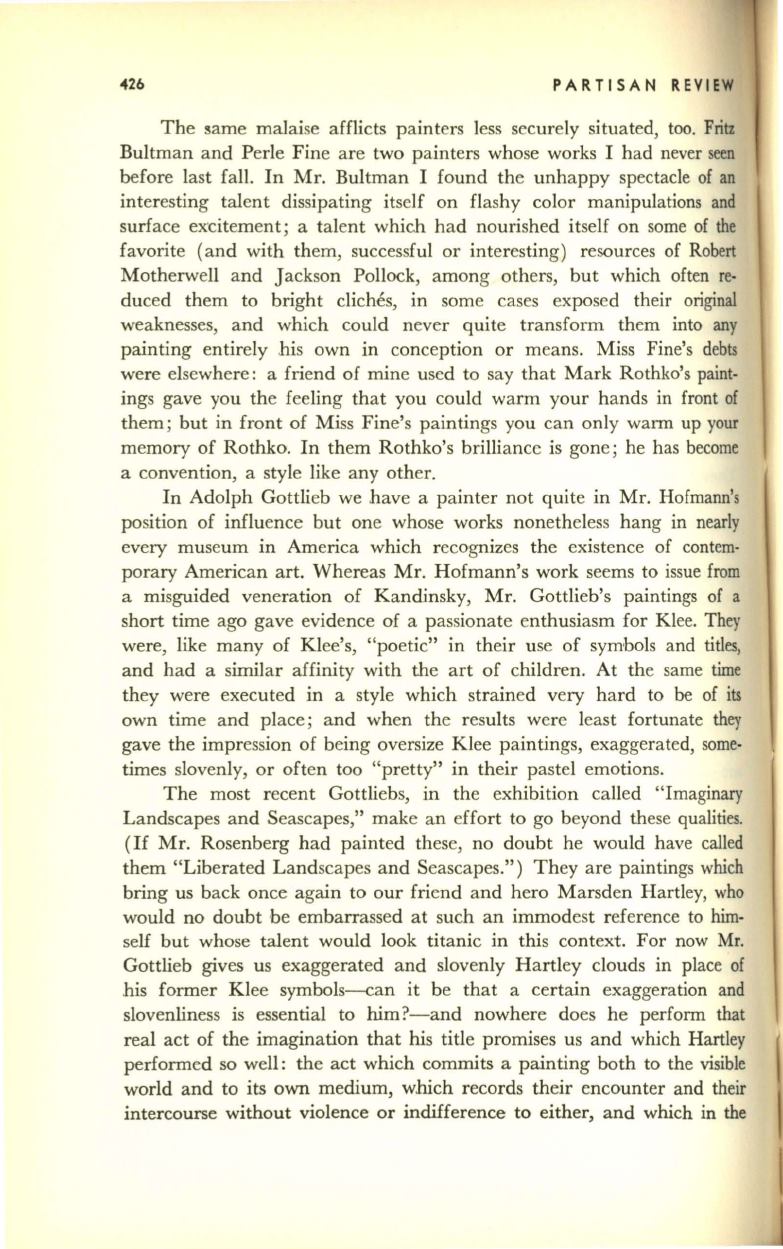
-426
PARTISAN REVIEW
The same malaise afflicts painters less securely situated, too.
Fritz
Bultman and Perle Fine are two painters whose works I had never seen
before last fall. In Mr. Bultman I found the unhappy spectacle of an
interesting talent dissipating itself on flashy color manipulations and
surface ex"Citement; a talent which had nourished itself on some of the
favorite (and with them, successful or interesting) resources of Robert
Motherwell and Jackson Pollock, among others, but which often re–
duced them to bright cliches, in some cases exposed their original
weaknesses, and which could never quite transform them into any
painting entirely his own in conception or means. Miss Fine's debts
were elsewhere: a friend of mine used to say that Mark Rothko's paint–
ings gave you the feeling that you could warm your hands in front of
them; but in front of Miss Fine's paintings you can only warm up your
memory of Rothko. In them Rothko's brilliance is gone; he has become
a convention, a style like any other.
In Adolph Gottlieb we have a painter not quite in Mr. Hofmann's
position of influence but one whose works nonetheless hang in nearly
every museum in America which recognizes the existence of contem–
porary American art. Whereas Mr. Hofmann's work seems to issue from
a misguided veneration of Kandinsky, Mr. Gottlieb's paintings of a
short time ago gave evidence of a passionate enthusiasm for Klee. They
were, like many of Klee's, "poetic" in their use of symbols and tities,
and had a similar affinity with the art of children. At the same time
they were executed in a style which strained very hard to
be
of its
own time and place; and when the results were least fortunate they
gave the impression of being oversize Klee paintings, exaggerated, some–
times slovenly, or often too "pretty" in their pastel emotions.
The most recent Gottliebs, in the exhibition called "Imaginary
Landscapes and Seascapes," make an effort to go beyond these qualities.
(If
Mr. Rosenberg had painted these, no doubt he would have called
them "Liberated Landscapes and Seascapes.") They are paintings which
bring us back once again to our friend and hero Marsden Hartley, who
would no doubt be embarrassed at such an immodest reference to him–
self but whose talent would look titanic in this context. For now Mr.
Gottlieb gives us exaggerated and slovenly Hartley clouds in place of
his former Klee symbols--can it be that a certain exaggeration and
slovenliness is essential to him?-and nowhere does he perform that
real act of the imagination that his title promises us and which Hartley
performed so well: the act which commits a painting both to the visible
world and to its own medium, which records their encounter and their
intercourse without violence or indifference to either, and which in the


